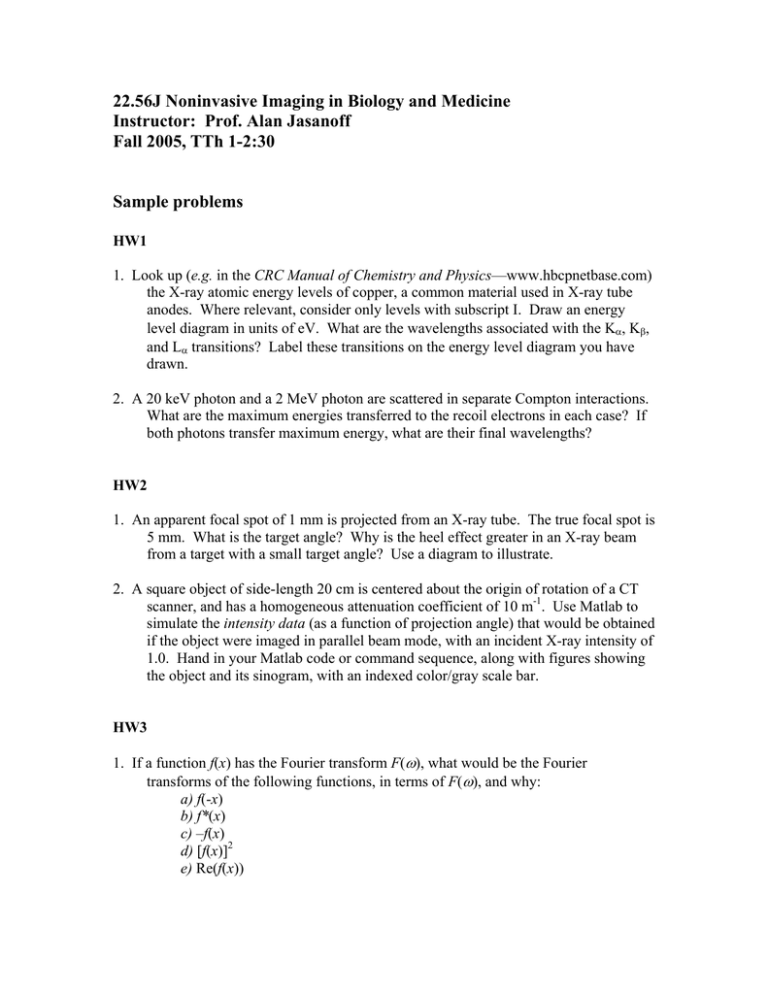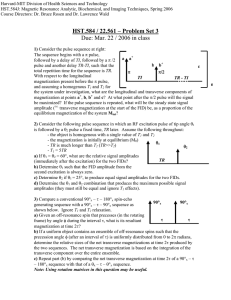22.56J Noninvasive Imaging in Biology and Medicine Fall 2005, TTh 1-2:30
advertisement

22.56J Noninvasive Imaging in Biology and Medicine Instructor: Prof. Alan Jasanoff Fall 2005, TTh 1-2:30 Sample problems HW1 1. Look up (e.g. in the CRC Manual of Chemistry and Physics—www.hbcpnetbase.com) the X-ray atomic energy levels of copper, a common material used in X-ray tube anodes. Where relevant, consider only levels with subscript I. Draw an energy level diagram in units of eV. What are the wavelengths associated with the Kα, Kβ, and Lα transitions? Label these transitions on the energy level diagram you have drawn. 2. A 20 keV photon and a 2 MeV photon are scattered in separate Compton interactions. What are the maximum energies transferred to the recoil electrons in each case? If both photons transfer maximum energy, what are their final wavelengths? HW2 1. An apparent focal spot of 1 mm is projected from an X-ray tube. The true focal spot is 5 mm. What is the target angle? Why is the heel effect greater in an X-ray beam from a target with a small target angle? Use a diagram to illustrate. 2. A square object of side-length 20 cm is centered about the origin of rotation of a CT scanner, and has a homogeneous attenuation coefficient of 10 m-1. Use Matlab to simulate the intensity data (as a function of projection angle) that would be obtained if the object were imaged in parallel beam mode, with an incident X-ray intensity of 1.0. Hand in your Matlab code or command sequence, along with figures showing the object and its sinogram, with an indexed color/gray scale bar. HW3 1. If a function f(x) has the Fourier transform F(ω), what would be the Fourier transforms of the following functions, in terms of F(ω), and why: a) f(-x) b) f*(x) c) –f(x) d) [f(x)]2 e) Re(f(x)) 2. In Matlab, a two dimensional 16 x 16 checkerboard pattern can be formed using the following set of commands: >> [x,y] = meshgrid(0:255,0:255); >> checkerboard = xor(mod(x,32)<16,mod(y,32)<16); Calculate the two dimensional Fourier transform of the checkerboard using the fft2 command in Matlab: >> checker_ft = fftshift(fft2(checkerboard,256,256)); Note that the fftshift command is necessary to shift the center of the transform to the center of the matrix (a quirk of Matlab). Display this matrix as a magnitude image [abs(checker_ft)] and describe the results, making sure that you scale the image to observe the “high resolution” components of the transform. Now use Matlab to form a 4 x 4 checkerboard pattern and a 64 x 64 pattern, and determine their Fourier transforms as above. What property of Fourier transforms determines the relationship between the “resolution” of the checkerboards and pattern of intensity you observe in their FTs? HW4 1. Following the approach we took in class, use the Central Slice Theorem to derive the formula for the filtered back-projection algorithm. 2. Use the radon and iradon functions to explore the dependence of number of projection angles on the reconstructions obtained in CT. This time, create a starting image by typing object = phantom in Matlab. If you display the image, you will see that it is a set of “blobs” meant roughly to approximate the cross-section of a human head. Generate projection data using radon(object,dth:dth:180), where dth is the angle between successive projections. Show reconstructions obtained from 6, 18, 60, and 180 projections. Now using the projection data obtained from object_radon = radon(object,1:1:180), show the effect of reducing the number of effective X-ray beams by a factor of ~10. Hint: use a subset of the rows in the object_radon matrix. HW5 1. Calculate the interval at which elution from a 99Mo-based 99mTc generator should be performed in order to maximize the yield of 99mTc per elution, assuming perfect elution efficiency. What will the total yield of 99mTc be as a percentage of the starting amount of 99Mo when this elution interval is used indefinitely? How could the recovery of 99mTc be made more efficient? 2. Two 511 keV photon detectors are spaced apart from each other at a distance of one meter. With what time resolution would detection events have to be registered in order to distinguish accurately the origins of positron annihilation events between the two detectors with a spatial resolution of 1 cm? HW6 1. Collimators in gamma cameras have an acceptance angle (dashed lines in figure below) determined by the length l of the collimator and the diameter d of its aperture. Show that the volume of tissue sampled at a distance r from the distal end of the collimator (rectangle) is proportional to 1/r2. Now consider the fraction of emission that reaches the collimator from the tissue volume at distance r (dotted lines) to show that the sensitivity of gamma photon detection (“efficiency”) is approximately invariant with distance. What is the effect on spatial resolution of the r-dependence of the sampled volume, and why? 2. Explain or derive the formula for the rate of random coincidences between any pair of detectors in a PET scanner: Rrandom = 2τS1S2 where τ is the time window within which coincidences must occur, and S1 and S2 are the singles rates of the two detectors. If 105 positron annihilations per second give rise to events detected evenly across a 100-detector PET scanner (in the absence of scatter and attenuation), what value of Rrandom would be observed for each pair of detectors, with τ = 100 µs, and what fraction of the total number of events would this represent? HW7 1. Iodine is essential to the production of thyroid hormones; iodide ions circulating in blood are excreted through the kidneys or taken up by the thyroid gland, which then incorporates them into thyroid hormones T3 and T4. These processes can be studied using the positron emitting 124I isotope. Assuming that the rate of hormone release from the thyroid gland is negligible, develop a three compartment model that accounts for blood iodine, excretion by the kidneys, uptake and rerelease by the thyroid, and rate of incorporation into thyroid hormone—draw the model in schematic form. What are the state equations for the model you developed (in terms of concentrations, and assuming an input function is given)? 2. Suppose you wish to measure the amount of a drug bound to cell-surface receptors distributed throughout a patient’s body. You have in your possession a radiolabeled analog of the drug, and you know the binding constants Kd and Kd* for binding of the drug and analog, respectively, to the receptor. Suppose an unknown (and unchanging) quantity of the drug is already in the patient. Describe a method using PET to determine both the amount of drug present and the concentration of receptors (Bmax) as a function of location in the body. Assume that only two compartments are relevant—specifically bound and free—and that Kd and Kd* reflect partitioning of both the drug and PET analog between these two compartments. Also assume that the free concentrations of drug and analog are spatially homogeneous. HW8 1. What are the proton and natural abundance 13C densities in a 10% ethanol/90% water mixture? What would the relative sensitivities of 1H and 13C NMR experiments on this sample be, assuming all isotopes are present at natural abundance? How many distinct chemical shifts would be observed in the proton spectrum, and what would their relative amplitudes be? If a 14.1 T magnet is used to collect a proton FID from this sample, what is the minimum digitization rate required to resolve all of the proton peaks, assuming that the detector reference is placed at the chemical shift of water? You may need to look up some information to answer this problem. 2. Consider the following pulse sequence: The sequence begins with a π pulse, followed by a delay TI, followed by a π/2 pulse and another delay TR – TI, such that the total repetition time for the sequence is TR. With respect to the longitudinal magnetization present before the π pulse, and assuming a homogenous T1 and T2 for the system under investigation, what are the longitudinal and transverse components of magnetization at points a*, b, b*, and c? At what point after the π/2 pulse will the signal be maximized? If the pulse sequence is repeated, what will be the steady state signal amplitude (i.e. transverse magnetization at the start of the FID) be, as a proportion of the equilibrium magnetization of the system Mtot? HW9 1. A typical gradient echo imaging experiment is conducted with multiple repetitions of the pulse sequence, using a recycle time TR. For a specimen with a fairly homogeneous T1 relaxation rate and TR of order T1, it is found that the image signal is maximized for an excitation pulse angle (called the “Ernst angle”) somewhat less than 90°. Determine the pulse angle that optimizes the gradient echo signal, in terms of arbitrary TR and T1. 2. Explain how the pulse sequence “module” shown below could act to suppress MRI signal from flowing but not static protons. Assume both pulses rotate magnetization in the same direction. Show graphically what happens to the bulk magnetization vector throughout this sequence, and represent the effect of the pulse sequence in k-space. What effect would changing the amplitude of the gradient pulses have on the efficiency of flow suppression? HW10 1. A “smart” T1 contrast agent has an “on” state with relaxivity R1on and an “off” state with relaxivity R1off, and is used at concentration c. Assuming a background T1 (in the absence of agent) of T10, what value of TR will maximize the T1-weighted gradient echo signal change produced by this agent, and what will the signal change be, as a percentage of the signal with the agent in its “off” state? 2. Explain with reference to the Solomon-Bloembergen-Morgan equations how and why the following physical parameters affect the inner sphere relaxivity of a T1 contrast agent: (a) molecular size of the agent (b) number of coordination sites available for water binding (c) exchange rate of water molecules off the paramagnetic metal (d) magnetic field at which T1 is measured





